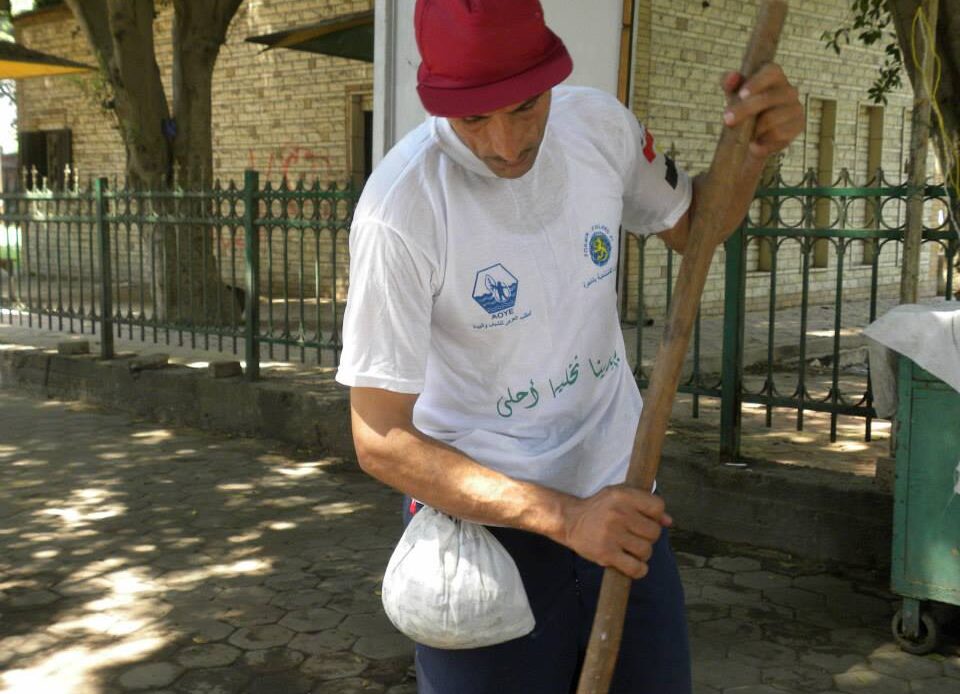Environmental Street Project - Five Phases
The Arab Office for Youth and Environment pioneered an initiative to create a model street known as the “Environmental Street,” exemplifying a fully integrated, environmentally sustainable street. This initiative was first implemented in 1999 across six governorates: Beni Suef, Minya, Hurghada, Sohag, Menoufia, and Suez. The project successfully demonstrated a model of partnership between all community stakeholders, including the government, citizens, and NGOs, with support and funding from the Local Environmental Initiatives Facility (known as the LIFE program). This program focused on a dialogue as a means of establishing communication channels between the community and decision-makers, which led to the project’s outstanding success, as reflected in its final evaluation. Accordingly, the project expanded to create 16 model environmental streets.

General Objective
The project aims to demonstrate the feasibility of implementing a model for an integrated environmental street and a dedicated environmental hotline in several Egyptian governorates. The approach relies heavily on community participation by activating environmental laws, particularly Law No. 4 of 1994, by receiving complaints from citizens and forwarding them to the relevant authorities to solve issues, particularly in the targeted streets and generally, in the participating governorates. This establishes a comprehensive partnership between the target groups, governmental bodies and non-governmental organizations.

Detailed Objectives
- Mobilize the local community to make optimal use of available material and human resources.
- Create a model of partnership.
- Promote local-level dialogue.
- Raise general environmental awareness among citizens.
- Improve the aesthetic appearance of streets in several Egyptian governorates.
- Educate citizens on the environmental laws, particularly Law No. 4 of 1994.
- Establish a communication channel between the community and decision-makers through the environmental hotline.
- Form supervisory committees representing all concerned parties to oversee the project.
- Activate partnerships between governmental and non-governmental organizations and encourage the community to take positive action on environmental issues.
- Develop a highly aware group of community leaders involved in all stages of the project.
- Engage the business and private sectors to participate in such projects and financially support them.
Implementation Sites
Cairo, Giza, Qalyubia, Suez, Menoufia, Beni Suef, Minya, Sohag, Alexandria, Hurghada, Beheira, North Sinai, Sharqia, and Qena.
Partners
Arab Office for Youth and Environment (AOYE)
Funds
Ford Foundation – NGO Service Center “USAID”
Project Duration
36 months

Expected Project Outcomes
- Issuance of a decision by each governorate to allocate a budget for expanding and implementing the Environmental Street concept.
- Providing job opportunities for youth of both genders, contributing to community development through various project activities.
- Organizing 36 public conferences across the target governorates, attended by a wide range of citizens representing the grassroots population. The conferences will invite officials such as governors, city council heads and representatives from the Ministries of Health, Interior, Media, and Environment to establish direct communication between citizens and officials, foster a sense of responsibility among the community, and create a strong collective voice to influence decision-makers.
- Holding 20 conferences (10 press conferences and 10 national conferences) to announce the project’s goals and achievements.
- Organizing 24 public hearings as part of the environmental hotline service, attended by a large number of citizens, officials and decision-makers to directly address environmental issues and provide immediate solutions.
- Establishing a permanent communication channel between citizens and decision-makers through the environmental hotline, allowing citizens to report issues and get immediate solutions.
- Conducting 42 community awareness seminars, covered by various media outlets (print, radio, and television) to ensure the idea reaches as many citizens and governorates as possible, and to apply pressure on decision-makers to respond to the project’s demands.
- Executing 16 model streets under the “Environmental Street” concept, adhering to environmental standards such as cleanliness, building facades painting, green spaces, rooftop gardening, organized waste collection, noise pollution reduction and energy-efficient lighting systems.
